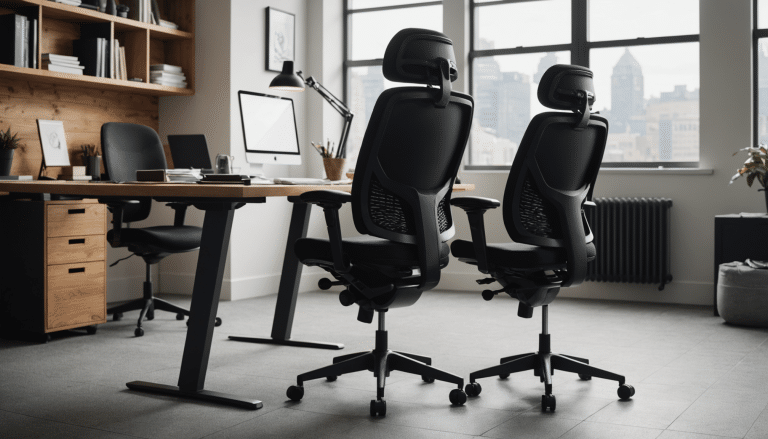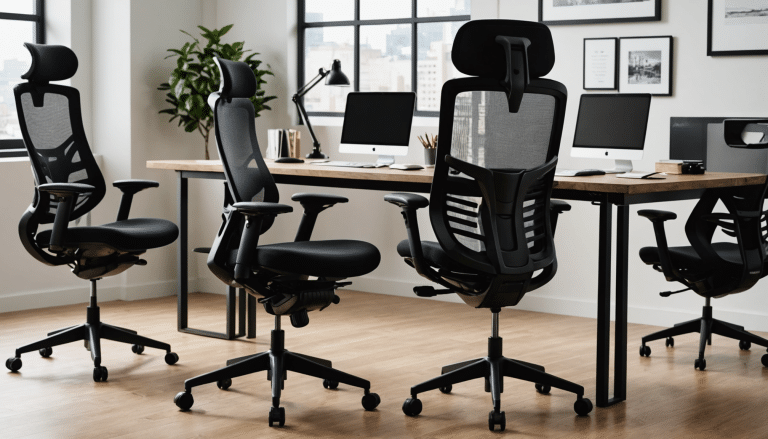Office Chair Guide
Choosing an office chair might not seem like a priority but being comfortable at work has been proven to help with your productivity and affect your long-term physical health. With 58% of people saying they spend over 5 hours at their desk a day, this is an awfully long time to go feeling uncomfortable and can affect your day-to-day life. If you’re using a monitor, the wrong height could lead to neck strain. Similarly, without adequate support from your chair, you could be left with back pain.
Limiting the damage of these things should be central to your consideration when choosing a new office chair. Here at Viking, we understand the importance of being comfortable and healthy in the workplace. Our guide will tell you everything you need to know to make the right decision for your employees.
How tall should a desk chair be?
The best advice we can give when choosing an office chair is making sure it’s adjustable. How tall a desk chair should be really depends on the individual, and being able to take control of the height will allow you to find the optimum position for you. A chair that’s too low can cause lower-back pain, carpal tunnel syndrome and rotator-cuff strain in the shoulder. If it’s set too high it can lead to Golfer’s Elbow – which is pain and inflammation on the inner side of your elbow. Injury caused by poor posture at your desk can cause you serious issues in and out of the office.
So, to avoid these injuries you have to find the right chair ergonomics for you. To help measure the correct height, stand in front and face your chair. It’s recommended that the highest point of the seat is level with the lower part of your kneecap, then once you sit down you should find your feet rest flat on the floor with your knees at a 90° angle. This is the best lower body position for sitting at your desk.
Once you have your chair at the correct height, you can use it to look at the ergonomics of the rest of your desk. You should be able to comfortably fit and cross your legs under your desk. If not, it needs raising. Or if you find you need to raise your arms to reach your keyboard, then your desk is too high. You will find you’re most comfortable with your elbows level with the top of the desk.
What to look for in a computer chair?
When considering what makes a good computer chair, as we mentioned before, adjustable settings is a must. This allows you to make sure your chair is the perfect fit for you.
Other things you should consider when looking for a new office chair are:
Lumbar support: An adjustable lumbar support will give you the freedom to model your chair to fit your lower back. This is particularly important if you’re looking to avoid back strain or any further long-term injuries.
Wheelbase: Having wheels on the base of your chair is more important than it would seem. During the working day, you don’t consider how often you move and reach to grab items from yours or a colleague’s desk. Rolling is important for preventing strain when stretching for such items.
Swivel base: Similar to the wheelbase, anything that frees up your movement while in your chair will stop you unnecessarily straining for things. A swivel base allows you to turn freely when it’s required.
Fabric: Making sure the material is comfortable should be a priority, but you will also want it to be breathable. Breathable fabric will stop the chair becoming too hot and uncomfortable. A cushion will also add to the comfort of the chair as you will no longer be able to feel the base when sitting down.
Test the chair: This isn’t something you can necessarily look for but testing a chair before you purchase can make an important difference. Ensuring you’re comfortable and it offers the right support will help you make the right choice.

Viking Malaga Executive Chair Basic Tilt Bonded leather Fixed Armrest Height Adjustable Seat Black 110 kg

Realspace Draughtsman Chair Permanent Contact Fabric Height Adjustable Black 110 kg 430 x 480 x 1,200 mm

Viking Malaga Executive Chair Basic Tilt Bonded leather Fixed Armrest Height Adjustable Seat Black 110 kg

Realspace Draughtsman Chair Permanent Contact Fabric Height Adjustable Black 110 kg 430 x 480 x 1,200 mm
Ergonomic Chair Guide
To fully consider your health and comfort while you’re at your desk you need to look at the ergonomic aspects of a chair. We have covered the height, but you need to make sure other adjustments are made to both the chair and your desk to ensure maximum comfort. Here are some other ways to adjust to a more ergonomic chair design:
Arm support: The arm support on your chair should be adjusted so your arms rest comfortably at a 90° angle along the sides of your body. If you don’t have adequate arm support it can cause your shoulders to hunch forward, and eventually cause discomfort in the neck and spine.
Computer screen: When positioning the screen on your desk, you should have the top of the screen placed at eye level. Higher or lower will cause you to lean forward or back to look at it, putting constant strain on your body. If you work on a laptop, the laptop should be boosted up so it’s at eye level and an external keyboard should be placed within reach. External keyboards aren’t expensive and are important for comfort at your desk.
Keyboard: You want to adjust your chair so can get close to your desk in order to reach your keyboard with ease. Make sure you have enough space under your desk and the arm support is the correct height. You should ensure your keyboard is positioned close enough to the body so that it isn’t necessary to lean forward to reach it.
Sitting comfortably at your desk is important for your health and your productivity. If you find you’re aching or in pain during the working day it will affect your work and lead to discomfort away from the office. Follow the advice in our guide to help you take care of you or your employee’s physical health and set you up for a comfortable and productive day at work.










